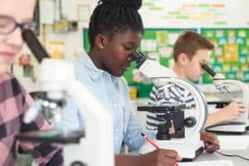Natural and Artificial Selection Inquiry Lab
Middle School Inquiry Lab on Natural and Artificial Selection
In this lab students will model natural selection by simulating a population of bunnies that have variation in their fur. They will be challenged to understand what happens to both desirable and undesirable genes over time, how the environment can affect populations, and how natural and artificial selection affect a population.
Each inquiry lab will contain an essential question that will drive the lesson and make students think. For this lesson, the essential question is:
- How does natural selection cause populations to change over time? What happens to beneficial and deadly genes over time?
BACKGROUND INFORMATION AND MATERIALS LIST:
Students will begin the lab by reading the essential question and background information. This can be done individually, as lab groups, or as a whole class. If you consider lab groups, you also might include some type of whole class formative checks before digging into the lab.

Materials List:
- 50 dry brown beans
- 50 dry white beans
- plastic cup labeled “breeding grounds”
- plastic cup labeled “graveyard”
- breeding placemat
- colored pencils
PROCEDURE:
For this lab to work, students should have a basic understanding of traits, dominant and recessive genes, and Punnett squares. It is important to note that this activity does not represent exactly what would occur with a population of real bunnies, but rather simulates the change in allele frequency over time.
Students randomly remove combinations of beans (bunnies) from the breeding cup and place the pair combination in the correct circle on the breeding placemat. All pairs of recessive genes, at the end of each round, will be placed in the graveyard cup. Once all beans (bunnies) have been removed from the breeding cup, survivors will once again enter the cup for another round. Students will continue until that have repeated the activity 10 times (reached 10 generations).
Students will take the data from each trial and calculate allele frequencies for each generation. This data will help them, since for the final piece of the activity, students will create a double-line graph showing how the frequencies of dominant and recessive genes fared.
CHECK FOR UNDERSTANDING:
At this point in the lab, students will be checked for understanding by answering questions about their findings. Here are a few that come with the lab:
- Why are Ff bunnies born with fur even though they have one recessive allele?
- Does the total number of F alleles ever change? Why do you think this is?
CONCLUSION
Students will go back to the essential question and write a CER (Claim, Evidence, Reasoning) to conclude the lab. Once completed, students will reflect back on their learning by answering the following questions:
- What happens to the frequency of the F allele as the number of F alleles changes?
- Do you think all of the groups in your class got the same numbers as you in their data tables? Why or why not?
- Is this how real-life populations of organisms work? How could the experiment be changed to simulate a real-life population of bunnies?
- What are some other traits in a population of bunnies in a cold, snowy environment that could be considered undesirable?
- In a real-life scenario involving these bunnies, what would happen to the recessive f alleles over time? Why or why wouldn’t the f alleles be eliminated completely?
MODIFIED AND INDEPENDENT INQUIRY VERSIONS
All of the Kesler Science inquiry labs come with three different modification levels. Each lab is differentiated using the icons below.
STANDARDS ALIGNMENT
TEKS: 7.11B – Explain variation within a population or species by comparing external features, behaviors, or physiology of organisms that enhance their survival such as migration, hibernation, or storage of food in a bulb.
NGSS: MS LS1-5 – Construct a scientific explanation based on evidence for how environmental and genetic factors influence the growth of organisms.
NGSS: MS LS4-6 – Use mathematical representations to support explanations of how natural selection may lead to increases and decreases of specific traits in populations over time.

Download Over $100 in FREE Resources
For Middle School Science
Simply create a login below and gain immediate access to a selection of our Kesler Science product line worth $100 - for FREE. There's a full version of every product type! You'll also join tens of thousands of middle school science teachers who receive timely tips and strategies straight to their inbox.





